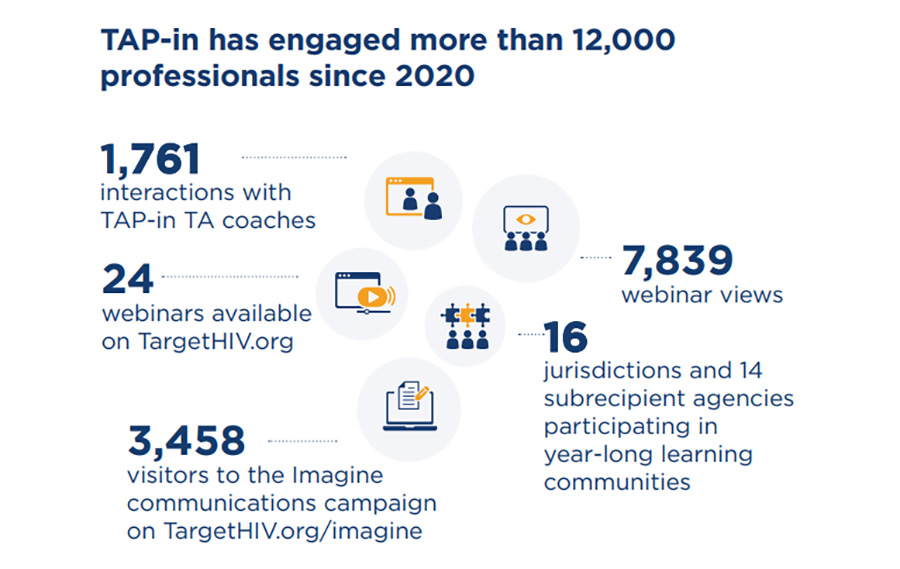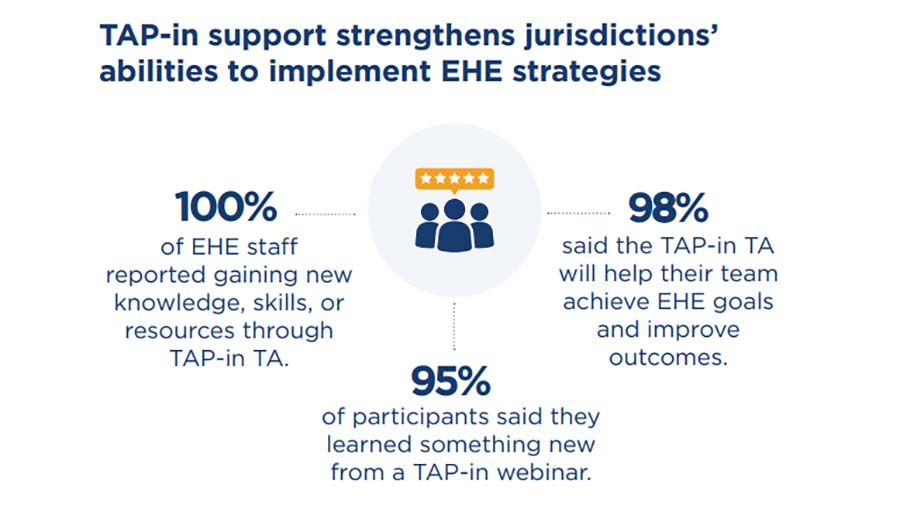TAP-in provides tailored technical assistance and resources to help key governmental agencies and service providers in 47 jurisdictions in the U.S. reduce new HIV infections.
The federal government aims to reduce the number of new HIV infections by 75 percent in 2025 and by 90 percent in 2030 by directing new funds to areas of the country with the highest HIV rates, as part of its initiative, Ending the HIV Epidemic in the U.S. To make this ambitious vision a reality, state and local organizations and leaders working to identify, prevent, and treat new cases of HIV need training, support, resources, and information about innovative new approaches and best practices.
The initiative
The Technical Assistance Provider–innovation network (TAP-in) provides an array of support to health care providers, government leaders, community-based organizations, and others in 47 jurisdictions in the U.S. that are funded by the federal government’s HIV/AIDS Bureau. We help jurisdictions strengthen their Ending the HIV Epidemic plans, and we help them increase their capacity to implement the plans.

Our work through the TAP-in project is tailored to meet each jurisdiction’s specific needs:
- We bring in experts, partner organizations, technology, and resources, and we provide capacity building so that jurisdictions and their partner agencies have effective systems in place to identify people newly diagnosed with HIV and engage those who are not in care or not virally suppressed.
- We deploy jurisdiction-specific coaches to provide intensive, focused technical assistance.
- We host webinars and learning collaboratives to improve knowledge of innovative HIV strategies. Ninety-five percent of webinar attendees reported that they learned something new.
- We convene learning collaboratives to accelerate implementation of strategies.
- We promote the use of real-time data to inform the development of new resources and strategies.
- We promote leadership development to ensure successful implementation.
The impact
TAP-in fulfills dozens of requests for assistance on topics including rapid antiretroviral therapy, housing, community engagement, linkage to care, and data sharing and regularly hosts webinars on timely topics such as syndemics and methamphetamine use as a driver of the HIV epidemic. TAP-in webinar recordings are posted on targethiv.org.

Project funder and key partners
Funder: The Health Resources and Services Administration HIV/AIDS Bureau, Ending the HIV Epidemic branch
Partners: The University of California at Los Angeles Department of Family Medicine is our principal partner. Other key partners include the Southern AIDS Coalition, Housing Works, the National Association of Community Health Centers, the Black AIDS Institute, the National Coalition of STD Directors, Mid-Atlantic AIDS Education Training Center, University of Mississippi Medical Center—Telehealth Center of Excellence, Amida Care, Mission Analytics, WRMA, and a pool of expert technical assistance specialists.
Project contact
Sharon R. Novey, M.S.P.H., Project Director: tap-in.contact@dev.caiglobal.org.
